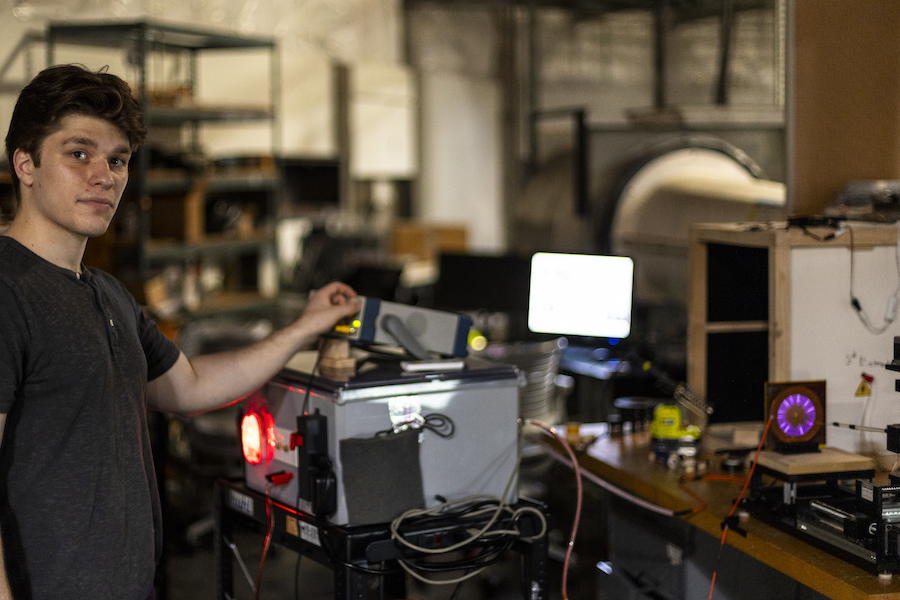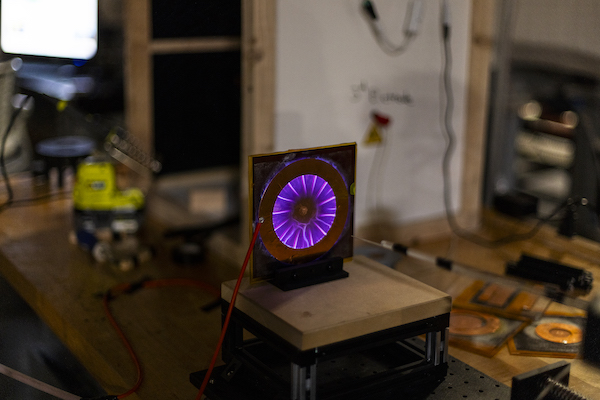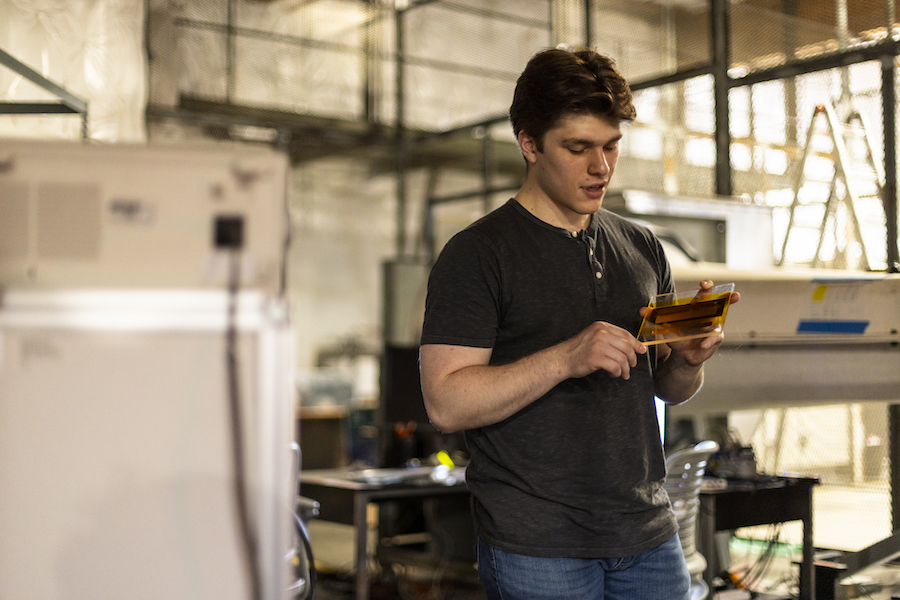By Lyra Fontaine
Photos by Dennis Wise/University of Washington
Studying electrical flow sparked an ME student’s decision to pursue graduate education.

Ben Price adjusts the current on the power supply box to apply voltage across a plasma actuator, shown on the right.
Ben Price (BSME ’23) hadn’t planned to go to graduate school. He hoped to join the workforce post-graduation. But after working as a research engineer for the Novosselov Research Group (NRG) – as well as receiving support such as the Mary Gates Research Scholarship – he changed his mind.
“I realized that I am interested in developing new technologies, designing devices and learning new things,” he says. “I have learned a lot in my undergraduate degree, but that has only made it more obvious to me how little I know.”
After stumbling upon the lab through the UW’s undergraduate research opportunities database, Price joined the NRG last year as a research assistant. Since then, the lab has connected him to faculty and other students across campus – a welcome camaraderie following the remote learning period of COVID-19. Price also appreciates the opportunities to grow his research skills and leadership experience.
ME Research Associate Professor Igor Novosselov has been Price’s mentor for the past two years.
“As an undergraduate research assistant, Ben quickly became a valuable contributor to a number of research activities,” says ME Research Associate Professor Igor Novosselov, Price’s mentor. “Over the past year, I have seen his growth toward becoming a more independent researcher and a leader in the lab. With one second-author paper in review and a nearly finished first-author publication, Ben is on track to becoming a productive researcher in a complex, multidisciplinary research area.”
Real-world research experience
Price studies electrohydrodynamics, the flow of electrically charged particles or plasma. His team applies a high voltage across an actuator that uses the electrical current to change the flow of air. They then research the dynamics of the plasma that is created by the process. The goal is to enable the actuators to actively modify flow for potential applications such as improving aircraft structures’ aerodynamic performance. One example of active flow control is the flaps on the back of an airplane wing.
“I cannot stress enough how important it is for up-and-coming engineers to get experience with real problems that don't have a direct solution online or in a textbook.”
“The flaps are able to extend, retract and bend up or down, adjusting the pressure gradient over the wing surface and thus the behavior of the aircraft,” he says. “This behavior is modifiable through real-time changes in geometry.”
Novosselov says Price’s research is important because plasma actuators have the potential to control a fluid system more rapidly, competing with traditional mechanical actuators.
“Over the past decade, there has been a great interest in using non-thermal plasma actuators for active flow control of aerodynamic surfaces,” Novosselov says.

The purple streaks of light indicate a high energy discharge where electrons flow through. Typically the researchers try to apply as much voltage as they can without getting them.
In the lab, Price enjoys puzzling over hands-on problems. For example, obtaining high-resolution data with high-voltage systems can be challenging because the instruments used to measure and record data are often sensitive to the electromagnetic fields produced by the actuators. He’s discovered simple yet effective solutions such as using metal boxes, covering unused outlets and proper grounding.
Long-term, Price is interested in using plasma to study fluid dynamics. In addition to electrohydrodynamics research, he contributes to research in the NRG that works to destroy “forever chemicals,” or Per- and Polyfluoroalkyl Substances (PFAS). PFAS – which can persist in water, soil, air and food – may have harmful health effects. Price studies how plasma can “pop” bubbles created by liquid samples of PFAS. Popping the bubbles helps destroy the forever chemicals.
Pursuing a Ph.D.
Both Price’s positive research experiences and the UW’s financial support played a role in his decision to pursue a Ph.D. In addition to receiving the Mary Gates scholarship in winter 2023, he qualifies for the Husky Promise, which guarantees eligible Washington state students grants and scholarships that fully cover the cost of the UW’s tuition.

Price holds an actuator that his team created using thin copper sheets.
“The financial support guaranteed by the Husky Promise has changed my trajectory and enabled my education and experiences thus far,” Price says. “As I came close to graduating and seriously considering further education, I realized that it would be financially possible at the UW, thanks to the support of the ME department.”
As Price enters his first year of graduate school this fall, Novosselov will continue to be his mentor. Price will build upon his electrohydrodynamics research by improving the efficiency of the actuator designs and finding new ways to model complex systems. The researchers are currently working on manipulating flow over aircraft wings, and their next stage of work will involve implementing the active flow control methods on aircraft and other structures. Price’s team tests the actuators in the wind tunnel to see how they might affect an airplane wing’s force, lift, drag and torque.
“We’re working to answer questions that have never been answered before,” he says.
Originally published October 2, 2023